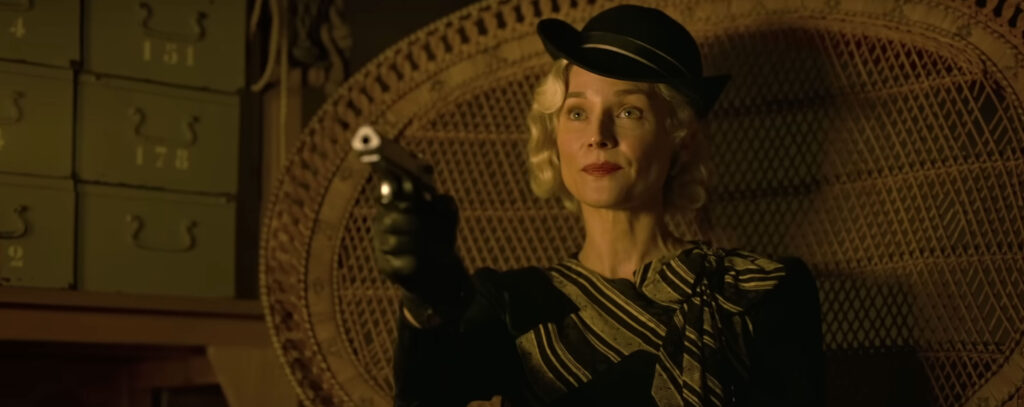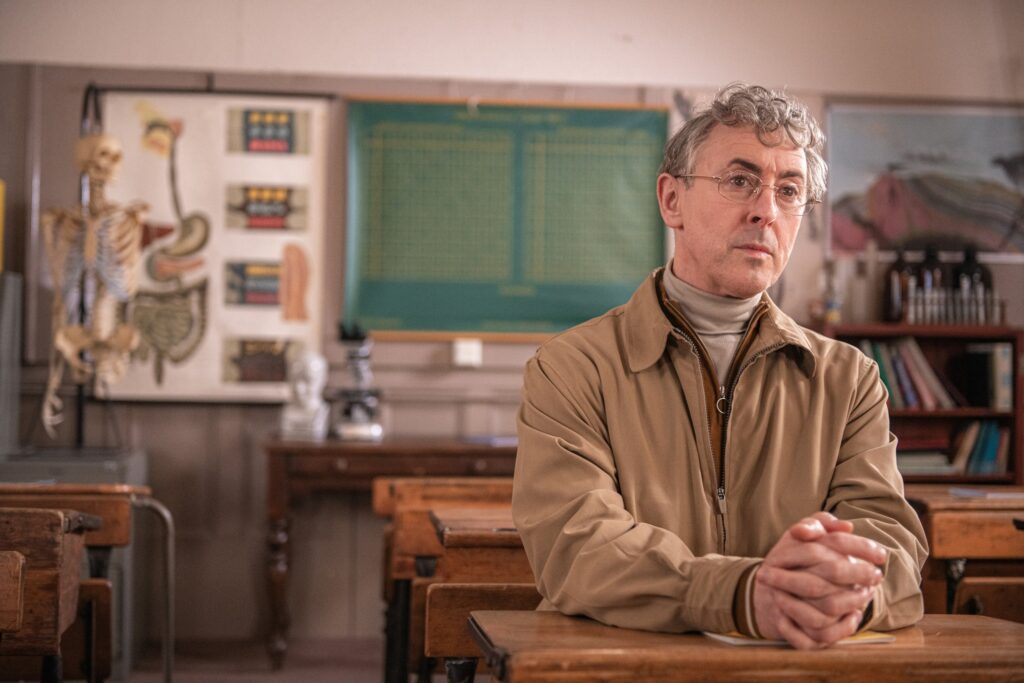September 1, 2023
by Carla Hay

Directed by Katie Holmes
Some language in Spanish with subtitles
Culture Representation: Taking place in New York City, the dramatic film “Rare Objects” (based on the 2016 novel of the same name) has a predominantly white cast of characters (with a few African Americans and Latin people) representing the working-class, middle-class and wealthy.
Culture Clash: A working-class college student, who is recovering from trauma in her personal life, gets a job at a high-end antiques store, where she meets some eccentric people who have backgrounds that are very different from hers.
Culture Audience: “Rare Objects” will appeal primarily to people who are fans of star/director Katie Holmes and slow-moving movies that don’t have much that’s interesting to say.

“Rare Objects” is a boring slog of a film with a flimsy plot and main characters who sound very phony. Katie Holmes has directed yet another cinematic misfire in which she’s cast herself as the star. Her awkward over-acting in “Rare Objects” does not help.
Holmes co-wrote the turgid “Rare Objects” screenplay with Phaedon A. Papadopoulos. They adapted the screenplay from Kathleen Tesaro’s 2016 novel of the same name. “Rare Objects” does something that most movies that take place in New York City don’t do: It actually makes vibrant, “love it or hate it” New York City look dull. The story in “Rare Objects” is fairly unfocused and doesn’t seem to have much of an idea about what do with the main characters, who sort of meander along in life and have very shallow conversations.
“Rare Objects” begins by showing protagonist Benita Parla (played by Julia Mayorga) in a major life slump. Benita is a student at the City University of New York, but she’s taking a break from school because she had an abortion after getting pregnant from rape. She also temporarily checked herself into a psychiatric facility for post-traumatic stress disorder.
Benita has flashbacks about the rape throughout most of the movie. Her rapist was on a dinner date with her on the night that he raped her. During this dinner date, he told her that he was new to the area and worked in finance. These flashbacks are put into the movie without further exploration about what these memories are doing to Benita.
Adding to Benita’s woes, she’s not completely over her ex-boyfriend Anthony (played by Giancarlo Vidrio), whom she hasn’t seen in a while. Benita decides to suddenly visit Anthony unannounced. He’s surprised to see her and tells Benita something that she doesn’t want to hear: He’s getting married. Any hope that Benita might have had that she and Anthony would get back together is now gone.
Benita has kept the rape and abortion a secret from most people who are close to her, including her best friend Angie (played by Olivia Gilliatt), who is a single mother to a baby. And so, when Benita tells her immigrant single mother Aymee Parla (played by Saundra Santiago), who works as a seamstress, that she’s taking a break from school and wants to move back in with Aymee, Aymee’s reaction is one of judgmental disappointment. Aymee thinks that Benita is just being a lazy flake, but ultimately she supports Benita’s decision and lets Benita move back in with her.
Benita is stressed-out about her student loans. Aymee tells Benita to be grateful for the opportunities that Benita has and to “just pray.” However, “just praying” doesn’t pay Benita’s bills, so she starts looking for a job. She sees an ad for a job as a sales assistant at the Colony Club, an upscale antiques store. Benita doesn’t know anything about antiques, so she goes into the interview with a “fake it ’til you make it” mindset.
Colony Club owner Peter Kessler (played by Alan Cumming) interviews Benita. Peter has high standards and is very fussy. He’s an elitist, but he’s not a mean-spirited person. Peter can sense that Benita doesn’t know much about antiques, but he hires her anyway because she seems pleasant and very eager to learn. He tells Benita that her job requires greeting and assisting clients and to be “attentive but un-presuming.”
A great deal of “Rare Objects” shows Benita working in the store and meeting a range of people who are usually wealthy. Two of those people are Diana Van der Laar (played by Holmes) and her brother James Van Der Laar (played by David Alexander Flinn), who have a slightly weird, overly co-dependent relationship. Diana takes a liking to Benita, and it isn’t long before Benita is hanging out with Diana when Benita isn’t working.
Diana has a lot of issues. She uses illegal drugs, and she’s spent time in a psychiatric facility through involuntary admission. Diana blames her haughty socialite mother Linda Van der Laar (played by Candy Buckley) for most of the emotional damage that Diana has. There’s a lot of cringeworthy dialogue in “Rare Objects,” and most of it comes from Diana.
When Benita tells Diana that she was raped, Diana’s response is: “When you think about it, it was a bad dream, like it never happened.” When the conversation turns to whether or not Diana and Benita have ever fallen in love with someone, Diana says to Benita: “Our mothers teach us how to be desired, but not how to be loved. I think you’re a goddess, made more perfect by experience.”
The movie is about two-thirds over when another character awkwardly shows up: His name is Ben Winshaw (played by Derek Luke), who is a married father working for the Colony Club, but he was away when Benita was hired. Benita is surprised to meet him because Peter never told her about Ben. In this role, Luke (who is American in real life) has a very fake-sounding Caribbean accent that we do not need to hear. “Rare Objects” starts to set up a subplot about a rivalry between Benita and Ben, but this subplot ultimately goes nowhere.
The character of Ben (and the phony accent that Luke gives this character) can best be described as “unnecessary” to this movie. One might assume that Luke is in “Rare Objects” because he was in Holmes’ 2022 flop “Alone Together,” which she wrote and directed. This Ben character looks like a role that was given to a friend so the friend could have a job, even though the role is not essential to the story. There’s nothing about “Rare Objects” that’s essential viewing, unless you want to see a lot of mediocre-to-bad acting in a lackluster movie that most people will forget soon after seeing it.
IFC Films released “Rare Objects” in U.S. cinemas, digital and VOD on April 14, 2023.




